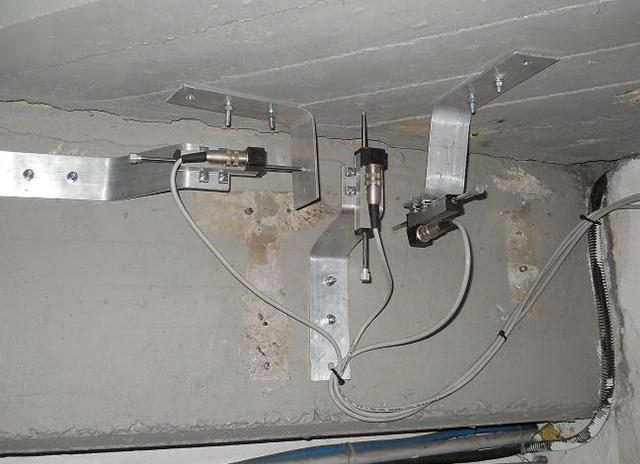MONITORAGGI STRUTTURALI DINAMICI
DYNAMIC STRUCTURAL MONITORING
- 12 Giu 2022

Le cause che inducono un manufatto a lesionarsi, possono essere il dissesto, il degrado o entrambe.
Il dissesto di un edificio può avvenire sostanzialmente per causa di tre fattori:
- sollecitazioni esterne (evento sismico, eccessiva spinta del vento ecc),
- sollecitazioni interne (assestamento degli elementi strutturali),
- sollecitazioni da redistribuzione dei carichi (apertura vani).
Il degrado invece arriva quando c’è una situazione di incuria o di vetustà degli elementi strutturali e che riporta, direttamente o indirettamente, alle ipotesi di dissesto.
Prima di intervenire su un opera con eventuali interventi di ripristino, è opportuno sottoporre per un periodo significativo l’opera ad un monitoraggio nel tempo, per valutare la variabilità ed entità dei fenomeni in atto (fessurazioni, cedimenti, ecc). Pertanto il monitoraggio tiene sotto controllo più fenomeni e si può avere un quadro generale di quanto sta accadendo. Si possono effettuare monitoraggi di fenomeni fessurativi, cedimenti differenziali inclinazioni, temperature, ecc.
Monitoraggi Strutturali Dinamici

La caratterizzazione dinamica di una struttura consiste nell’acquisizione dei parametri dinamici fondamentali del sistema come le frequenze proprie di vibrazione le forme modali. Tali parametri servono nella validazione di modelli numerici di strutture già realizzate, ipotesi comportamentali dell’organismo strutturale assunte in fase di progetto, valutazione della sicurezza delle strutture e per l’individuazione delle priorità di interventi di risanamento.
I sistemi per l’induzione delle vibrazioni sulle strutture possono essere artificiali (vibrazioni generate da forzanti o impulsive) o ambientali (vento, microsismi, traffico veicolare). La risposta ad eccitazioni naturali o forzate può essere ottenuta in termini di accelerazioni, velocità o spostamenti.
UNI 9614. La norma definisce il metodo di misura delle vibrazioni immesse negli edifici ad opera di sorgenti esterne o interne agli edifici stessi e prevede criteri di valutazione differenziati a seconda della tipologia della vibrazioni (di livello costante, di livello non costante e impulsive). I locali o gli edifici in cui sono immesse le vibrazioni sono classificati a seconda della loro destinazione d’uso in: aree critiche, abitazioni, uffici, fabbriche.
Le misure vengono eseguite su diversi piani dell’edificio monitorato, posizionando i sensori agli angoli opposti e orientati lungo le due direzioni principali. In questo modo è possibile cogliere non solo i modi traslazionali (X e Y) ma anche quelli torsionali. Le vibrazioni possono essere misurate rilevando il valore efficace dell’accelerazione che è espresso in m/s2 o mm/s2 o in termini di livello dell’accelerazione espresso in dB. Le accelerazioni da valutare sono quelle comprese nel range di frequenza tra 1 e 80 Hz e il dato da considerare è il valore quadratico medio delle accelerazioni presenti durante l’intervallo di tempo esaminato. I dati acquisiti vengono pre-processati mediante operazioni di filtraggio e campionamento. Successivamente vengono elaborati dall’algoritmo di identificazione il quale consente di estrarre i parametri modali (frequenze, forme modali e rapporti di smorzamento).
La stima dei modi strutturali avviene attraverso quello che viene chiamato “diagramma di stabilizzazione” che permette di depurare i modi stabili (modi di vibrare reali) da quelli instabili (modi puramente numerici).
Tale procedura consente di ottenere i principali parametri strutturali degli edifici, consentendo la visualizzazione delle principali forme modali associate alle frequenze proprie di vibrazione.
I dati ottenuti dal monitoraggio dinamico rappresentano preziose informazioni sul comportamento dinamico dell’edificio, non ottenibili attraverso il tradizionale monitoraggio statico. Tali parametri possono essere utilizzati per una serie di analisi e scopi:
- monitoraggio delle condizioni di salute strutturale (structural health monitoring);
- identificazione del danno (damage detection);
- calibrazione di modelli FEM (model updating).
UNI 9916. La norma fornisce una guida per la scelta delle metodologie appropriate per la valutazione degli effetti delle vibrazioni sugli edifici ed identifica le possibili sorgenti di vibrazione ed i fattori che influenzano la risposta strutturale dell’edificio alle vibrazioni. La norma si applica in generale a tutte le tipologie di edifici. La norma classifica le definizioni di danno in funzione degli effetti che le vibrazioni provocano agli edifici secondo la seguente terminologia:
- danno di soglia: formazione di fessure filiformi sulle superfici dei muri a secco o accrescimento di fessure già esistenti sulle superfici intonacate o sulle superfici di muri a secco; inoltre formazione di fessure filiformi nei giunti a malta delle costruzioni in mattoni e in calcestruzzo
- danno minore: formazione di fessure più aperte, distacco e caduta di gesso o pezzi di intonaco di muri a secco; formazione di fessure in blocchi di mattoni o di calcestruzzo
- danno maggiore: danneggiamento di elementi strutturali; fessure nelle colonne di supporto; apertura di giunti; serie di fessure nella muratura
 Ing. Andrea Petrarca
Ing. Andrea Petrarca
The causes that induce an artifact to be damaged, may be the disruption, degradation or simultaneous. The failure of a building can occur substantially due to three factors: external stresses (seismic event, excessive wind pressure, etc.), internal stresses (settlement of structural elements), stresses from redistribution of loads (opening rooms). Degradation, on the other hand, comes when there is a situation of neglect or age of the structural elements and that leads, directly or indirectly, to the hypothesis of disruption.
Before intervening on a work with any restoration work, it is advisable to subject it to monitoring over time for a significant period of time, to assess the variability and extent of phenomena in progress (cracks, subsidence, etc.). Therefore, monitoring keeps a number of phenomena under control and there is a general picture of what is happening. It is possible to monitor cracking phenomena, subsidence, differential inclinations, temperatures, etc.Dynamic Structural Monitoring
The dynamic characterization of a structure consists in the acquisition of the fundamental dynamic parameters of the system such as the own vibration frequencies and the modal forms. These parameters are used to validate numerical models of structures already built, behavioural hypotheses of the structural organism assumed in the design phase, evaluation of the safety of the structures and for the identification of priorities for rehabilitation interventions.
Systems for inducing vibrations on structures can be artificial (vibrations generated by forcing or impulsive) or environmental (wind, microseism, vehicular traffic). The response to natural or forced excitations can be obtained in terms of acceleration, speed or displacement.UNI 9614. The standard defines the method of measuring vibrations emitted into buildings by sources outside or inside the buildings themselves and provides for different evaluation criteria depending on the type of vibration (constant level, non-constant level and impulsive). The rooms or buildings in which the vibrations are placed are classified according to their intended use in: critical areas, homes, offices, factories.
Measurements are carried out on different floors of the monitored building, positioning the sensors at opposite angles and oriented along the two main directions. In this way it is possible to grasp not only the translational modes (X and Y) but also the torsional ones. Vibrations can be measured by measuring the rms value of acceleration which is expressed in m/s2 or mm/s2 or in terms of the acceleration level expressed in dB. The accelerations to be evaluated are those included in the frequency range between 1 and 80 Hz and the data to be considered is the average square value of the accelerations present during the examined time interval. The acquired data are pre-processed through filtering and sampling operations. Subsequently, they are processed by the identification algorithm which allows to extract the modal parameters (frequencies, modal forms and damping ratios).
The estimation of the structural modes is done through what is called “stabilization diagram” that allows to purify the stable modes (real vibrate modes) from the unstable ones (purely numerical modes).
This procedure allows to obtain the main structural parameters of buildings, allowing the visualization of the main modal forms associated with the own vibration frequencies.
The data obtained from dynamic monitoring represent valuable information on the dynamic behaviour of the building, which cannot be obtained through traditional static monitoring. These parameters can be used for a variety of analyses and purposes:
-structural health monitoring;
– damage detection;
– calibration of FEM models (model updating).UNI 9916. The UNI 9916 standard provides guidance for the choice of appropriate methodologies for assessing the effects of vibrations on buildings and identifies possible sources of vibration and factors that affect the structural response of the building to vibrations. The standard applies in general to all types of buildings. The standard classifies damage definitions according to the effects of vibrations on buildings according to the following terminology:
– maximum damage: formation of thread-like cracks on drywall surfaces or growth of existing cracks on plastered surfaces or drywall surfaces; also formation of thread-like cracks in mortar joints in brick and concrete buildings.
– lesser damage: formation of more open cracks, detachment and fall of gypsum or drywall plaster pieces; formation of cracks in brick or concrete blocks
– main damage: damage to structural elements; cracks in support columns; opening of joints; series of cracks in masonry

